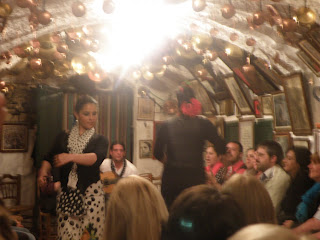Although Flamenco is often associated with the country of Spain it originated in the region of Andalusia. This artistic dance is said to have orginated duing the Reconquista period around the 15th century. There still remains some discrepancy on where and from who the word "flamenco" first emerged.
One of the most important aspects of Flamenco dance and music would be the singing or "cante". Originally flamenco was comprised purely of cante, with handclapping "palmas" or knuckle rapping as a form of percussion. The guitar, a variation of the Arabic Oud, was gradually incorporated in the 19th century. The strongest influences evident in the evolution of Flamenco singing and music can be traced from many elements including punjabi singing of India, jewish synagogue chants, andalusian regional folk forms, amongst others.
Dance seen in the Katak, NianiPuri, Kathakal and Bharatanatyam forms have been contributions to modern day Flamenco dance. Elements such as the deep-seated plie, outturned leg position, sharp angles of the body and arms, splayed fingers, rapid barrel turns and the percussive foot movements are integrated to make this dance an art form.
I had the pleasure of viewing a authentic Flamenco show in its native region in Andalusia. My classmates and I ducked into a cave-like room decorated with pots and photographs. Everyone sat in a circle and while we were served sangria, the Spanish guitar began. A man echoed the distinctive cante while all the others stomped their feet, snapped and fast paced clapped. Because of the shape of the room the Spanish man's distinctive voice echoed and was even more sharp then it would be in the open. The cante could be mistaken for wailing, but I found it to be dramatic and the perfect balance to the serenity of the Spanish guitar.
There were three dancers two women and one man. The dancing began with both the women. The brows furrowed with concern and determination.
The actual dance was classified by sharp agressive turns and movements. Hand clappin above the head follwed by stomping movements. When both the women danced together they seemed to look into each other eyes, never smiling until the song was over and they had returned to their seats. This is probably one of the most authentic culutural events I attended while studying in Spain.
From what I witnessed there has been very little development of Flamenco since the Inquisition and a huge contrast to the modern society of Madrid.






No comments:
Post a Comment